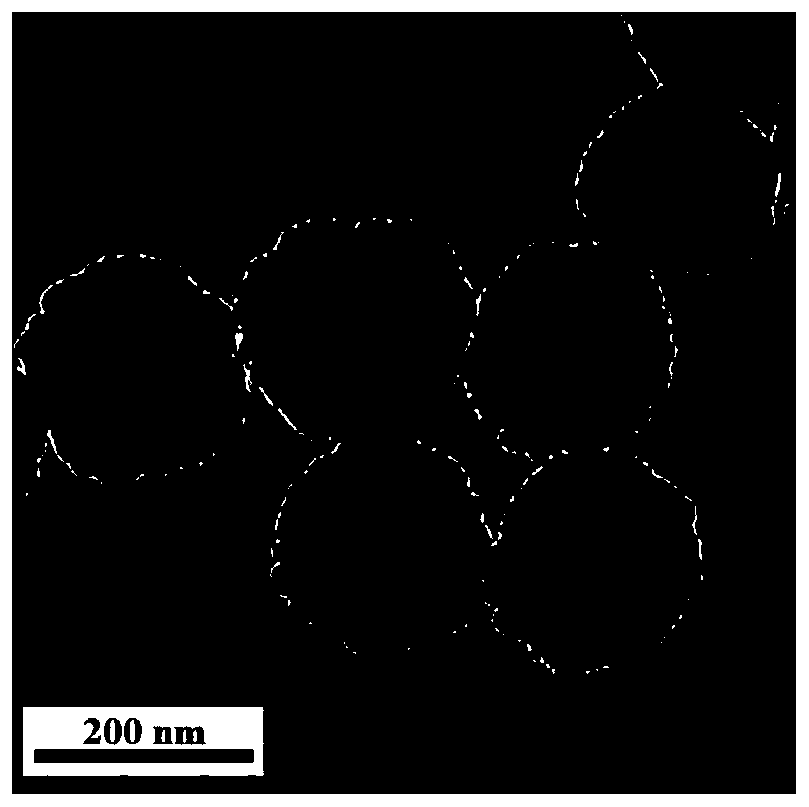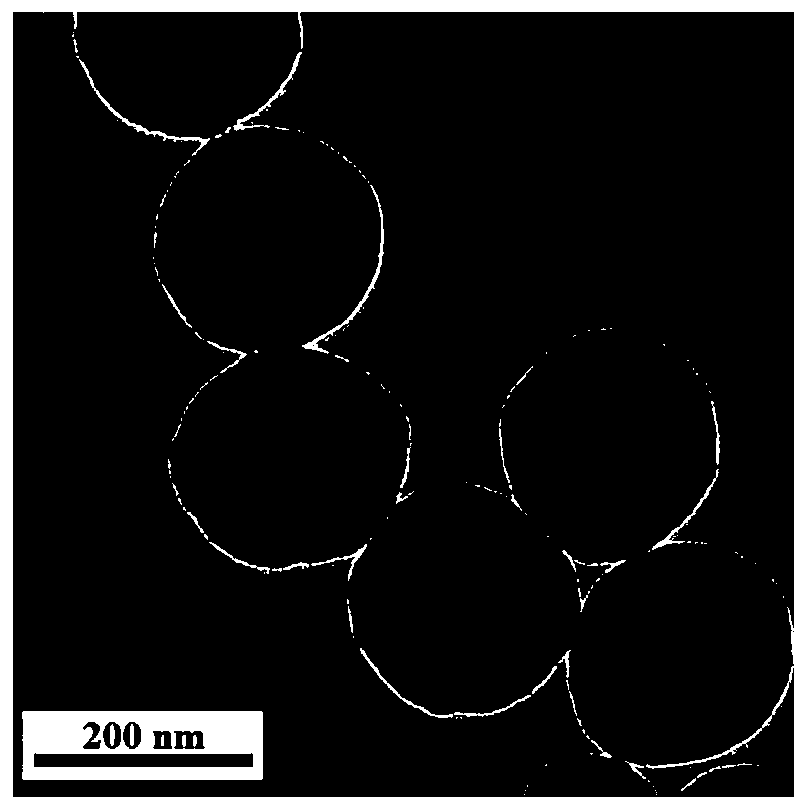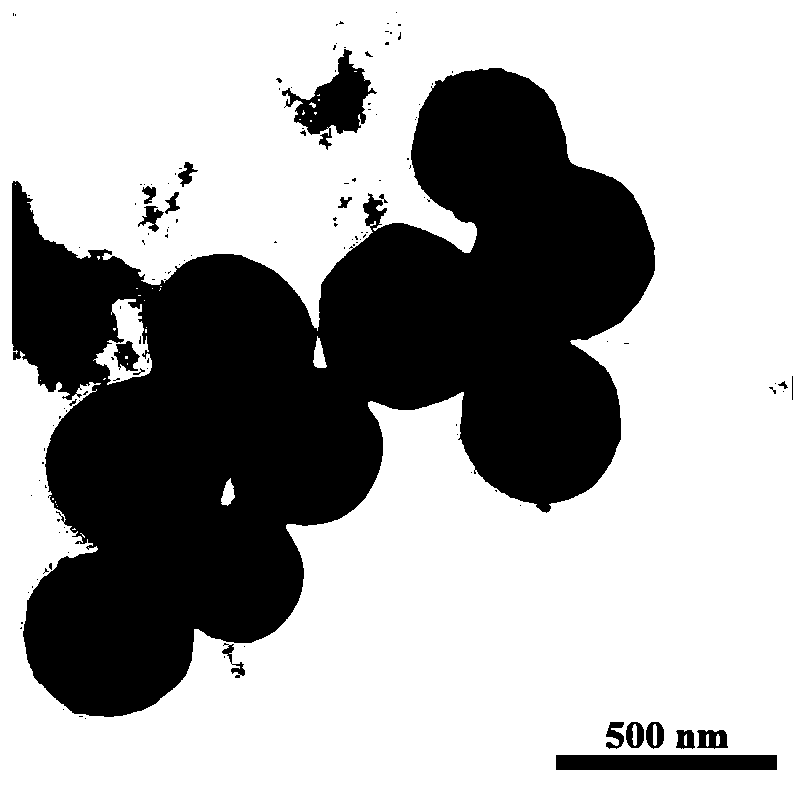Erythrocyte membrane coated bionic blood hexavalent chromium reduction remover/magnetic nanomotor and preparation method and application thereof
A red blood cell membrane and magnetic nanotechnology, applied in the field of biomedical materials, can solve problems such as poor biocompatibility, achieve protective activity, improve biocompatibility, and broad application prospects
- Summary
- Abstract
- Description
- Claims
- Application Information
AI Technical Summary
Problems solved by technology
Method used
Image
Examples
Embodiment 1
[0043] Hydrothermal Synthesis of Fe 3 o 4 NPs. Weigh 2.7g (10mmol) of ferric trichloride hexahydrate and fully dissolve it in 80mL of ethylene glycol. 7.2 g of sodium acetate and 0.9 g of sodium citrate were added with stirring. Stirring was continued for 30 min, and the mixture was transferred to a high-temperature reactor at 200° C. for 20 h. After natural cooling, the product was washed several times with deionized water and ethanol successively by magnetic separation method, and the product was vacuum-dried at 60°C. Magnetic Fe 3 o 4 NPs transmission electron microscopy such as figure 1 As shown, the size is about 200nm.
[0044] Weigh 150mg Fe 3 o 4 Disperse in 90mL of water, add 1.5mL of hydrazine hydrate solution (50%) to it, and after ultrasonication for 30min, add 210mL of water to it to make the pH of the solution = 9-10, continue to drop 96μL of TEOS into the solution, and stir at 90°C After reacting for 2 hours, the product was washed with water three tim...
Embodiment 2
[0050] Hydrothermal Synthesis of Fe 3 o 4 NPs. Weigh 2.7g (10mmol) of ferric trichloride hexahydrate and fully dissolve it in 80mL of ethylene glycol. 7.2 g of sodium acetate and 0.9 g of sodium citrate were added with stirring. Stirring was continued for 30 min, and the mixture was transferred to a high-temperature reactor at 150° C. for 25 h. After natural cooling, the product was washed several times with deionized water and ethanol successively by magnetic separation method, and the product was vacuum-dried at 60°C. Weigh 150mg Fe 3 o 4 Disperse in 90mL of water, add 1.5mL of hydrazine hydrate solution (50%) to it, and after ultrasonication for 30min, add 210mL of water to it to make the pH of the solution = 9-10, continue to add 96μLTEOS dropwise to the solution, and stir at 90°C for reaction After 2 hours, the product was washed with water three times by magnetic separation. Continue to disperse the solid product in 210mL water, add 2.4mL hydrazine hydrate and 0.4...
Embodiment 3
[0055] Hydrothermal Synthesis of Fe 3 o 4 NPs. Weigh 2.7g (10mmol) of ferric trichloride hexahydrate and fully dissolve it in 80mL of ethylene glycol. 7.2 g of sodium acetate and 0.9 g of sodium citrate were added with stirring. Stirring was continued for 30 min, and the mixture was transferred to a high-temperature reactor at 250° C. for 15 h. After natural cooling, the product was washed several times with deionized water and ethanol successively by magnetic separation method, and the product was vacuum-dried at 60°C. Weigh 150mg Fe 3 o 4 Disperse in 90mL of water, add 1.5mL of hydrazine hydrate solution (50%) to it, and after ultrasonication for 30min, add 210mL of water to it to make the pH of the solution = 9-10, continue to add 96μLTEOS dropwise to the solution, and stir at 90°C for reaction After 2 hours, the product was washed with water three times by magnetic separation. Continue to disperse the solid product in 210mL water, add 2.4mL hydrazine hydrate and 0.4...
PUM
| Property | Measurement | Unit |
|---|---|---|
| Thickness | aaaaa | aaaaa |
Abstract
Description
Claims
Application Information
 Login to View More
Login to View More - R&D
- Intellectual Property
- Life Sciences
- Materials
- Tech Scout
- Unparalleled Data Quality
- Higher Quality Content
- 60% Fewer Hallucinations
Browse by: Latest US Patents, China's latest patents, Technical Efficacy Thesaurus, Application Domain, Technology Topic, Popular Technical Reports.
© 2025 PatSnap. All rights reserved.Legal|Privacy policy|Modern Slavery Act Transparency Statement|Sitemap|About US| Contact US: help@patsnap.com



